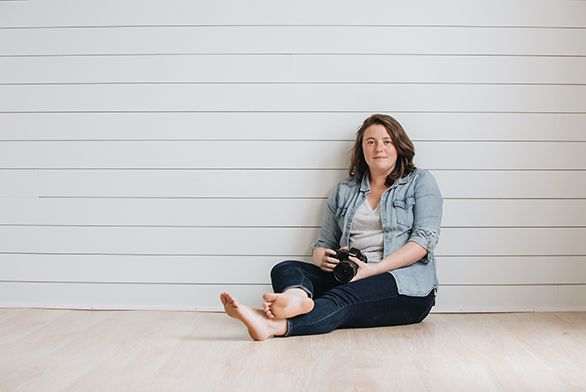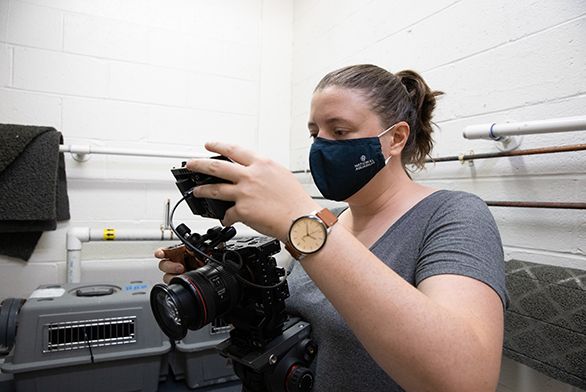Henley Moore (A13): Documenting Baltimore’s National Aquarium
May 10, 2021 | By Les Poling

The National Aquarium in Baltimore is an iconic landmark of the mid-Atlantic, with a stunning geometric stone-and-glass façade that overlooks the city’s historic inner harbor. To many, those two destinations are vastly different. The aquarium is a pristine architectural monument filled with natural life; the harbor, on the other hand, is a bustling seaport neighborhood that, for centuries, has existed to facilitate human industry—accumulating pollution along the way.
But to Henley Moore (A13), the harbor and the aquarium are intimately connected, and not just by proximity. As multimedia producer for the National Aquarium—what her manager calls the aquarium’s “in-house documentarian”—Moore works on video creation, chronicling the aquarium’s work and its relationship with the outside world by developing stories, filming material, leading interviews, and editing the footage into a public-facing product.
“With internet-based media, we are able to expose people to environments that they may never go to, people they may never have the opportunity to meet, and ideas that they may not have thought of,” she explains. “For example, people walk past the inner harbor in Baltimore, constantly ready to write it off as inhabitable—but in fact, crabs, herons, and gilly fish all call it home.”
“If I can show you what lives there, a place that is polluted and in need of a lot of work, and spark some curiosity about it, then my hope is that curiosity will carry over and inspire you to connect with your immediate world,” she adds.
It’s fitting that Moore spends her days using creative acumen to inspire curiosity in others; a similar yearning for exploration initially led her to apply to St. John’s. Moore grew up in Maryland, and as a result always knew about the Great Books college tucked away in Annapolis. However, she recalls, “as a kid with dyslexia who was always placed in the lowest reading group, it didn’t seem like the place I was ever going to need to know more about.” That changed as she grew older. “In high school, after building a better relationship with reading, what I saw as traditional college classes didn’t really appeal to me,” she explains.
On the advice of a particularly impactful high school teacher and counselor, Moore looked into St. John’s more seriously. “The concept of spending my four years of college learning through conversation was much more appealing than sitting in a lecture hall listening to someone talk for a semester,” she remembers. Especially effecting was an admissions video in which a current student told the story of two alums—a lawyer and a farmer—talking about how St. John’s helped them in their respective careers. The lawyer discussed critical thinking, the ability to analyze complex information. The farmer, on the other hand, said St. John’s taught them why to be a farmer. “At 18, I didn’t know exactly what I wanted to be, but I wanted to find out what I needed to be,” Moore says. She began her first semester at St. John’s the following fall.
Her time at St. John’s proved instructive—especially regarding everything she didn’t (and still doesn’t) know. From Euclid and her freshman essay to captaining Kunai and after-class conversations with strangers, “I started to learn how to be comfortable and excited about the fact that I may never know the answers, I may never be fully prepared, but as long as I can be alright with that discomfort, I can make progress,” Moore says.
“The polity as a whole opened me up to and encouraged me to take part in the constant discomfort—which later helped me learn the difference between discomfort and pain.”

Moore credits that oxymoronic comfort in discomfort as a constant source of confidence in her line of work. As multimedia producer, Moore helps the National Aquarium in its mission to inspire environmental conservation by connecting guests with animals in the building, holding science-based education programs, and leading hands-on field initiatives. Primarily, that means creating videos for the hundreds of thousands of people who follow the aquarium’s Facebook, Twitter, Instagram, and other digital channels.
“We aim to show our guests a behind-the-scenes look and connect people that may not be able to come to the building to our mission,” she says. “Some days I am out in the field filming rehabilitated turtles being released back to the ocean. Some days I am sitting in front of a computer for hours on end looking at footage and yelling at my past self for filming so much grass.”
Whether filming rehabilitated turtles or grass, Moore finds herself relying on the curiosity and inquisitiveness that she brought to and nourished at St. John’s. She notes that, given her liberal arts degree, she obviously didn’t go to school in order to work in video. That being said, “because I knew how to be curious, how to ask purposeful questions, and where to seek them out, I was able to stumble my way to this career/position/field,” she points out. The Program comes in handy in more tangible ways as well. Distilling complex concepts into simpler terms is as useful for creating social media content as it was for making a point in seminar, Moore says, and the ability to have probing conversations has been a boon during interviews.
But perhaps the most important tie between St. John’s and Moore’s position at the aquarium is the search for deeper meaning; the persistent drive to question, to seek truth and connection. “When I make a video about sea turtles, my hope is not that you come out knowing everything about sea turtles; rather, it’s that you are now curious about them and the world they live in,” she muses. “[I’m asking,] how can I open you up to this world so you can connect it with your own?”

